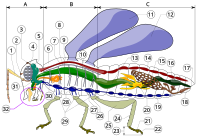
Photo from wikipedia
Physical activity enhances proximal femur bone mass, but it remains unclear whether the benefits translate into an enhanced ability to resist fracture related loading. We recently used baseball pitchers as… Click to show full abstract
Physical activity enhances proximal femur bone mass, but it remains unclear whether the benefits translate into an enhanced ability to resist fracture related loading. We recently used baseball pitchers as a within-subject controlled model to demonstrate physical activity induced proximal femur adaptation in regions associated with weight bearing and increased strength under single-leg stance loading. However, there was no measurable benefit to resisting common injurious loading (e.g. a fall onto the greater trochanter). A lack of power and a small physical activity effect size may have contributed to the latter null finding. Softball pitchers represent an alternative within-subject controlled model to explore adaptation of the proximal femur to physical activity, exhibiting greater dominant-to-nondominant (D-to-ND) leg differences than baseball pitchers. The current study used quantitative computed tomography, statistical parametric mapping, and subject-specific finite element (FE) modeling to explore adaptation of the proximal femur to physical activity in female softball pitchers (n = 25). Female cross-country runners (n = 15) were included as symmetrically loaded controls, showing very limited D-to-ND leg differences. Softball pitchers had D-to-ND leg differences in proximal femur, femoral neck, and trochanteric volumetric bone mineral density and content, and femoral neck volume. Voxel-based morphometry analyses and cortical bone mapping showed D-to-ND leg differences within a large region connecting the superior femoral head, inferior femoral neck and medial intertrochanteric region, and within the greater trochanter. FE modeling revealed pitchers had 19.4% (95%CI, 15.0 to 23.9%) and 4.9% (95%CI, 1.7 to 8.2%) D-to-ND leg differences in predicted ultimate strength under single-leg stance loading and a fall onto the greater trochanter, respectively. These data affirm the spatial and strength adaptation of the proximal femur to weight bearing directed loading and demonstrate that the changes can also have benefits, albeit smaller, on resisting loads associated with a sideways fall onto the greater trochanter.
Journal Title: Bone
Year Published: 2021
Link to full text (if available)
Share on Social Media: Sign Up to like & get
recommendations!